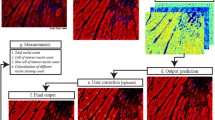Abstract
A substantial shift is occurring in the field of histopathology towards the digital domain with the increasing adoption of digital microscopy and large image databases. There is a growing need for image analysis tools that can efficiently and objectively analyse this wealth of digital image data. This paper presents preliminary results on the development of a suite of such tools for the measurement of toxic effects in the liver. We present an automated procedure for the measurement of one toxic effect, centrilobular hypertrophy, and present an evaluation of the components of this process. Centrilobular hypertrophy is a condition whereby liver cells in the region of central veins expand in response to a toxin. Our classification process has three stages. The first stage involves detecting the central veins using an interest point detection technique. In the second stage, the interest points are re-ranked to reduce the incidence of false positives. The third stage entails training a classifier to score the tissue in the regions of the putative central veins as hypertrophic or normal.
This research was supported by the IRCSET funded PhD programme in Bioinformatics and Computational Biomedicine bioinformatics.ucd.ie/phd/.
Access this chapter
Tax calculation will be finalised at checkout
Purchases are for personal use only
Preview
Unable to display preview. Download preview PDF.
Similar content being viewed by others
References
Cross, S.S.: Grading and scoring in histopathology. Histopathology, 99–106 (August 1998)
Cross, S.S.: Observer accuracy in estimating proportions in images: implications for the semiquantitative assessment of staining reactions and a proposal for a new system. J. Clin. Pathol. 54(5), 385–390 (2001)
O’Brien, M.J., Keating, N.M., Elderiny, S., Cerda, S., Keaveny, A.P., Afdhal, N.H., Nunes, D.P.: An assessment of digital image analysis to measure fibrosis in liver biopsy specimens of patients with chronic hepatitis c. Am. J. Clin. Pathol. 114(5), 712–718 (2000)
Matalka, Ismail, I., Al-Jarrah, Omar, M., Manasrah, Toqa, M.: Quantitative assessment of liver fibrosis: a novel automated image analysis method. Liver International 26(9), 1054–1064 (2006)
Harris, C., Stephens, M.: A combined corner and edge detection. In: Proceedings of the Fourth Alvey Vision Conference, pp. 147–151 (1988)
Wilson, H., Giese, S.: Threshold visibility of frequency gradient patterns. Vision Res. 17(10), 1177–1190 (1977)
Loy, G., Zelinsky, A.: Fast radial symmetry for detecting points of interest. Pattern Analysis and Machine Intelligence 25(8), 959–973 (2003)
Hamilton, P.W., Bartels, P.H., Thompson, D., Anderson, N.H., Montironi, R., Sloan, J.M.: Automated location of dysplastic fields in colorectal histology using image texture analysis. The Journal of Pathology 182(1), 68–75 (1997)
Diamond, J.: The use of morphological characteristics and texture analysis in the identification of tissue composition in prostatic neoplasia. Human Pathology 35(9), 1121–1131 (2004)
Haralick, R.M.: Statistical and structural approaches to texture. Proceedings of the IEEE 67(5), 786–804 (1979)
Graps, A.: An introduction to wavelets. IEEE Computational Science & Engineering 2(2), 50–61 (1995)
Strela, V., Heller, P.N., Strang, G., Topiwala, P., Heil, C.: The application of multiwavelet filterbanks to image processing. IEEE Transactions on Image Processing 8(4), 548–563 (1999)
Soltanianzadeh, H.: Comparison of multiwavelet, wavelet, haralick, and shape features for microcalcification classification in mammograms. Pattern Recognition 37(10), 1973–1986 (2004)
Jafari-Khouzani, K., Soltanian-Zadeh, H.: Multiwavelet grading of pathological images of prostate. IEEE Transactions on Biomedical Engineering 50(6), 697–704 (2003)
Xia, X.G., Geronimo, J.S., Hardin, D.P., Suter, B.W.: Design of prefilters for discrete multiwavelet transforms. IEEE Transactions on Signal Processing 44(1), 25–35 (1996)
Hardin, D.P., Roach, D.W.: Multiwavelet prefilters. 1. orthogonal prefilters preserving approximation order p⩽2. IEEE Transactions on Circuits and Systems II: Analog and Digital Signal Processing 45(8), 1106–1112 (1998)
Author information
Authors and Affiliations
Editor information
Editors and Affiliations
Rights and permissions
Copyright information
© 2010 Springer-Verlag Berlin Heidelberg
About this paper
Cite this paper
Foley, R., Gallagher, W., Callanan, S., Cunningham, P. (2010). A Machine Learning System for Identifying Hypertrophy in Histopathology Images. In: Coyle, L., Freyne, J. (eds) Artificial Intelligence and Cognitive Science. AICS 2009. Lecture Notes in Computer Science(), vol 6206. Springer, Berlin, Heidelberg. https://doi.org/10.1007/978-3-642-17080-5_10
Download citation
DOI: https://doi.org/10.1007/978-3-642-17080-5_10
Publisher Name: Springer, Berlin, Heidelberg
Print ISBN: 978-3-642-17079-9
Online ISBN: 978-3-642-17080-5
eBook Packages: Computer ScienceComputer Science (R0)




